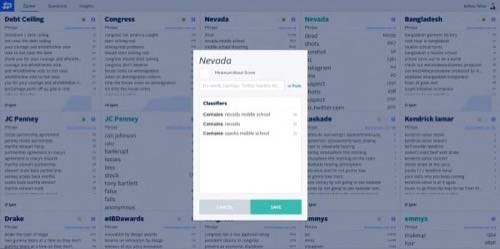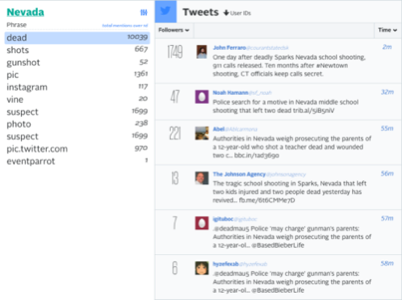
The conversation happening on social media sites like Twitter and Facebook is a reflection of what’s happening in the world around us, and whether people realize it, companies are mining data from posts to use in marketing and advertising.
But social analytics has become so advanced that it not only pulls data from text and images, but it can also predict trends and assist with responses during emergencies.
Poptip, a social analytics and instant polling platform, launched a tool today that enables brands, companies and the media to analyze and track a conversation happening on Twitter around a specific topic or group of people.
Companies like ESPN and the National Football League run social surveys with Poptip Questions to better understand what their viewers like. Poptip’s text analysis program breaks down the responses and produces a shareable results page for companies to distribute on websites and social media networks, as well as on air.
Now the New York-based company is expanding its offerings to include analysis and, eventually, prediction.
The new feature, called Zipline, lets users select words or phrases to track on Twitter, and Poptip monitors and reports the conversation.
For instance, a cosmetics brand can set a Zipline to track the conversation around makeup trends, and Poptip will determine the number of tweets per minute, how many phrases mention cosmetics and popular words that surface in the conversation.
“Trend prediction and trend recognition is what we’re trying to bring to the table,” said Poptip CEO and founder Kelsey Falter.
Brands and companies can also sign up for email alerts that summarize the social chatter around specific topics or events.
In Case Of Emergency, Tweet
There’s no reason why businesses or law enforcement can’t run the same analysis as fashion trends for social justice issues or emergencies.
Out of the gate, Zipline will focus on consumer brands and news networks, but Falter said that the tools she and her team have developed have the potential to be used in a variety of verticals like government, universities or non-profit organizations.
“What’s the common conversation around breast cancer, or immigration? That’s something we hope to offer in the future,” Falter said.
In a somewhat macabre demonstration of the company’s new tool, Falter took me through an analysis of the conversation surrounding the shootings at a Nevada middle school earlier this week.

In the few short minutes after the incident, we could see the top phrases included “dead,” “Nevada middle school,” “Sparks middle school” and “shots.” Poptip’s tool also sorted images containing similar words in the photo’s description, and we could find out which image was the first tweeted live from the scene.
With Zipline, media can track what people are saying about current events to get a sense of public opinion and identify common themes.

Social media is quickly becoming the go-to resource for news, and even social networks are recognizing the power they have to distribute breaking, life-saving news. Analytics tools like Poptip’s Zipline will be useful for determining what information is pertinent and what could be fabricated.
After the Boston Marathon bombing earlier this year that left three dead and 140 injured, social media became a cesspool of misinformation. Members of the popular social site Reddit posted an incorrect photo of the alleged terrorist suspect that circulated on Twitter and Facebook, eventually duping many journalists.
Zipline could help deter mistaken do-gooders in the future, by breaking down the conversation and helping the most accurate news surface.
In the case of a school shooting or terrorist attack, law enforcement can analyze the keywords and conversation happening in specific subject or demographic areas, and eventually cross-reference it to other conversations down the line.
Falter said she hopes her company will be able to get organizations like universities on board, and ultimately be able to provide alerts anytime the topic of conversation shifts by a major percentage, possibly stopping or containing any student safety issues.
A Work In Progress
Zipline will initially launch Twitter-only analysis, but Falter said that her company is focusing on being platform agnostic, so in the future brands and companies can run similar analyses on Facebook and Instagram.
Images courtesy Poptip










